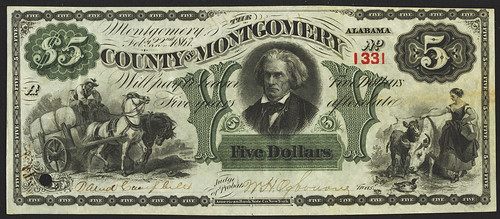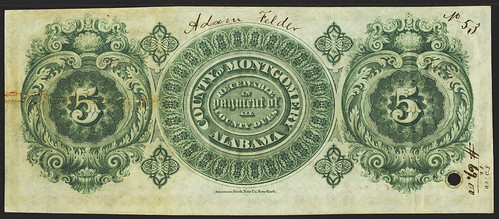
PREV ARTICLE
NEXT ARTICLE
FULL ISSUE
PREV FULL ISSUE
1867 MONTGOMERY ANTICIPATION NOTESHere's an excerpt of an article by Bill Gunther in the March/April 2020 issue of Paper Money from the Society of Paper Money Collectors (SPMC). Editor Benny Bolin kindly forwarded the text and images at my request. Thanks! -Editor Financing Government During Reconstruction: The County of Montgomery (Alabama) and their Revenue (Tax) Anticipation Notes of 1867  Immediately after the Civil War (April 1865) states, cities and counties throughout Alabama found themselves bankrupt and without a major source of revenue. Confederate and Alabama paper money that circulated during the war was now worthless. Even if there was some "money", shortages of manufactured goods, medical supplies as well as food drove prices beyond reach by most residents. Food was scarce due to the absence of the men who would have tilled and planted the crops and much of the existing food supply had been diverted to the military. It was estimated that as a result of these shortages, "a typical Southern family's food bill was $6.65 per month at the time of secession and $400 a month in 1864." While the tax base in many areas of the South was destroyed during the war, such destruction was minimized in the City of Montgomery. Local businessman, John Robert Powell, and others "...joined the Mayor and a group of leading citizens who rode out to meet the enemy and presented (Union) General Wilson the unconditional surrender of the city." This act of surrender, as well as the good behavior of the Union troops in Montgomery, is credited with allowing the city to escape major war damage. How to Pay for the Reconstruction
"Revenue Anticipation Notes"
The notes from the County of Montgomery do not use the words "Post Notes" but the term would clearly apply. They were printed by the American Bank Note Company. Henry Clay appears on the $1, Daniel Webster on the $2 notes while the $5 contains the image of John C. Calhoun. All of the notes carry the printed issue date of February 22, 1867.  For more information on the Society of Paper Money Collectors, see:
Wayne Homren, Editor The Numismatic Bibliomania Society is a non-profit organization promoting numismatic literature. See our web site at coinbooks.org. To submit items for publication in The E-Sylum, write to the Editor at this address: whomren@gmail.com To subscribe go to: https://my.binhost.com/lists/listinfo/esylum All Rights Reserved. NBS Home Page Contact the NBS webmaster 
|